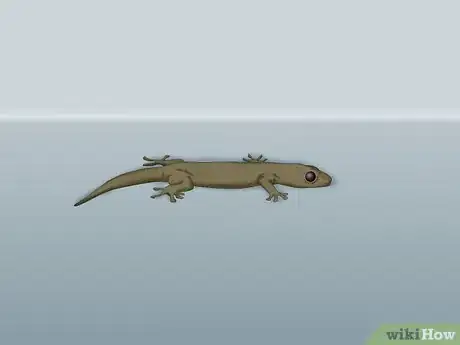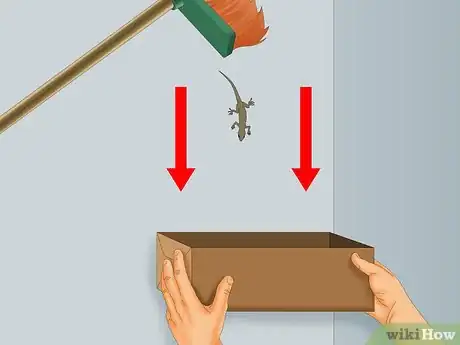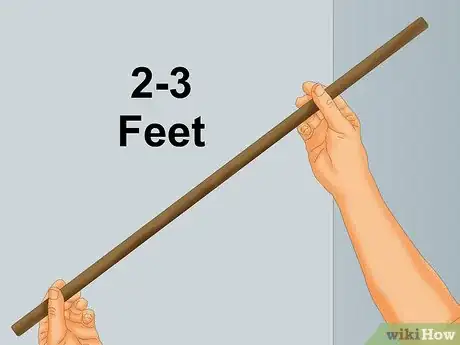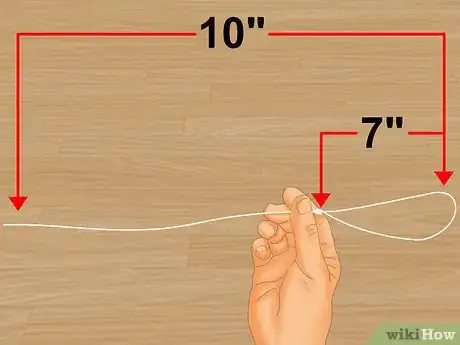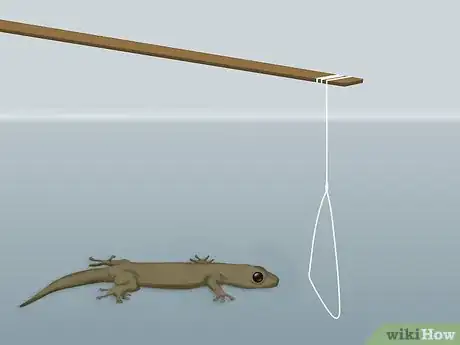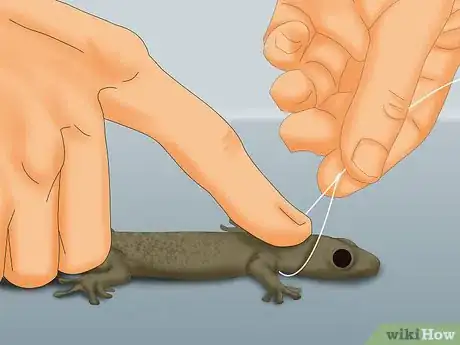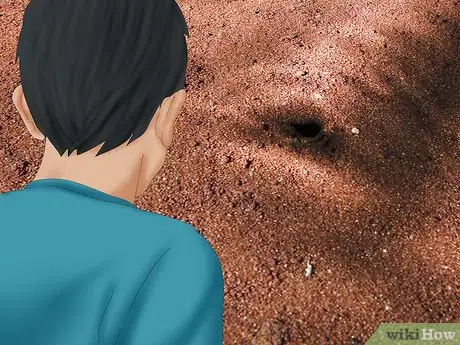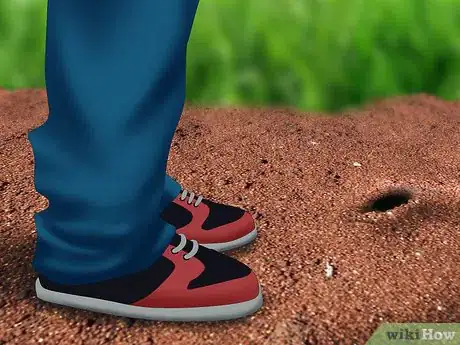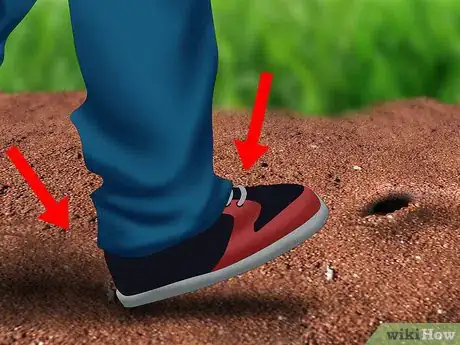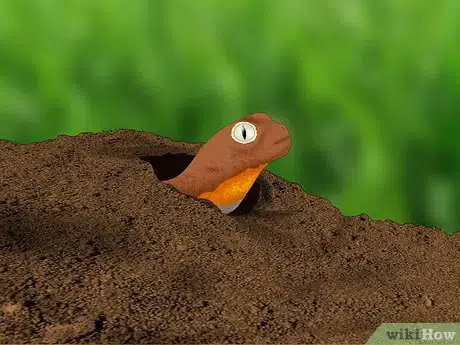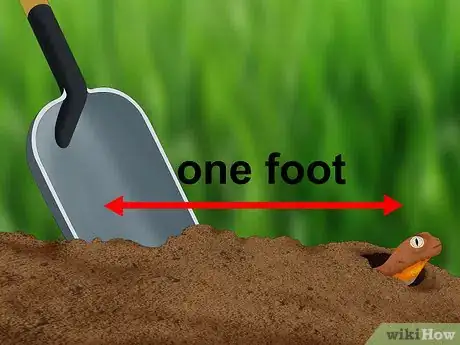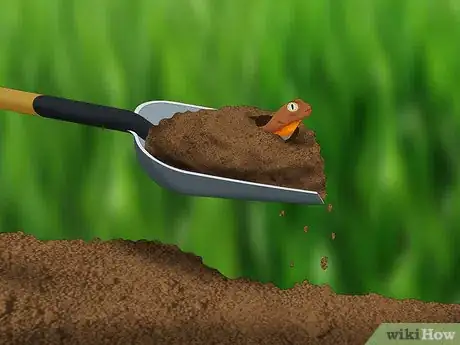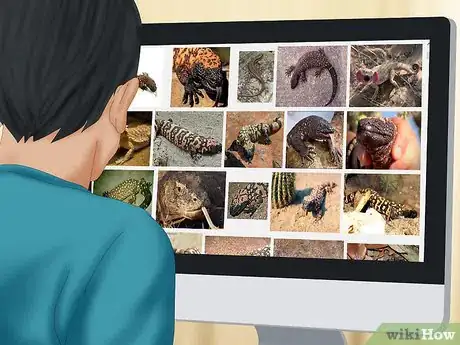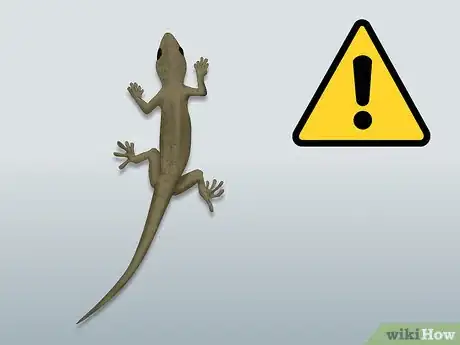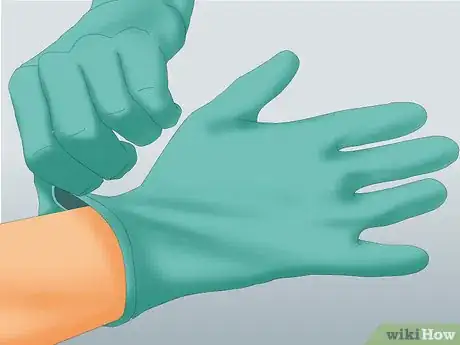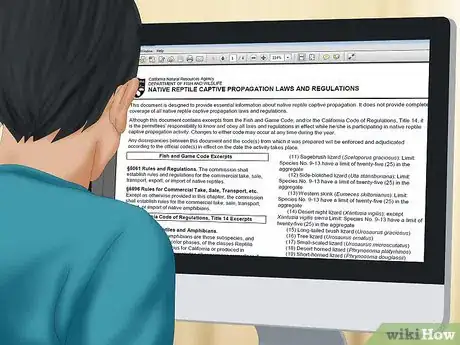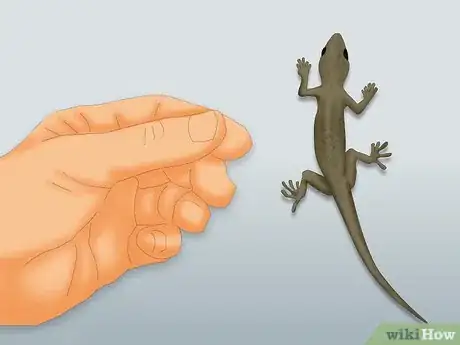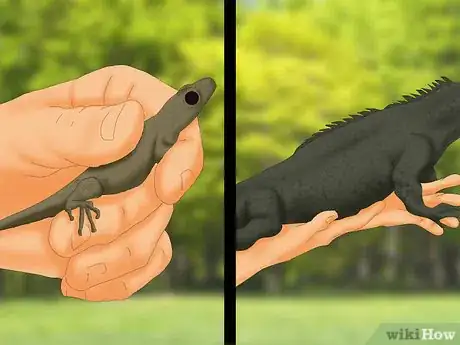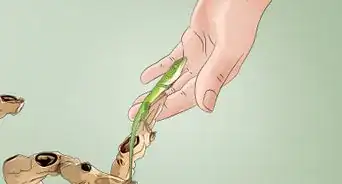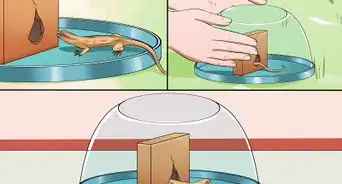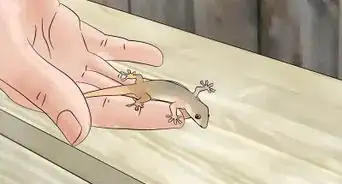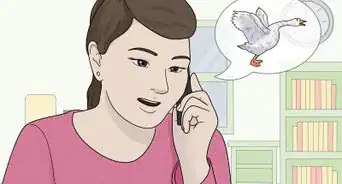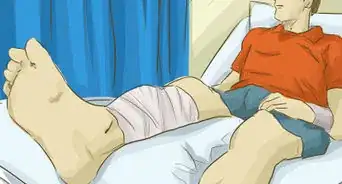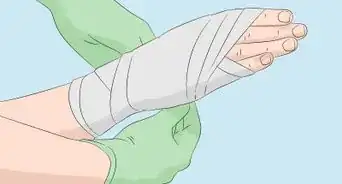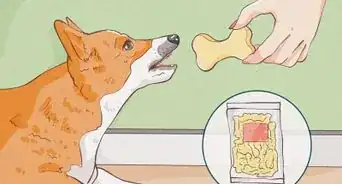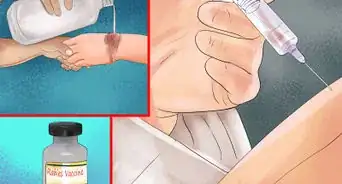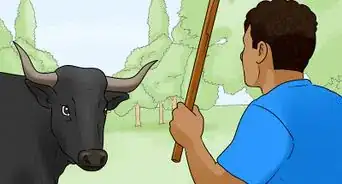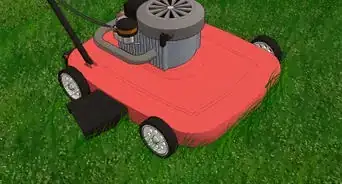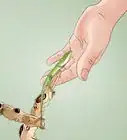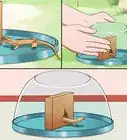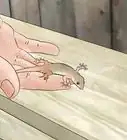This article was co-authored by wikiHow Staff. Our trained team of editors and researchers validate articles for accuracy and comprehensiveness. wikiHow's Content Management Team carefully monitors the work from our editorial staff to ensure that each article is backed by trusted research and meets our high quality standards.
There are 8 references cited in this article, which can be found at the bottom of the page.
This article has been viewed 87,736 times.
Learn more...
Many people enjoy catching and studying wild lizards. One way to catch them is to use a trap. But what happens when you see a lizard and don’t have time to obtain or make a trap? There are several options available for catching lizards without a trap. Whatever method you choose, always be gently and take care when capturing lizards so as not to hurt them.
Steps
Capturing a Lizard Inside
-
1Identify where the lizard is. Some lizards can move fast, while others move slow. If you find a lizard, you will need to act quickly to catch it. If it scampers off -- behind a piece of heavy furniture, for instance -- you will need to wait for it to reappear before making your move.
- If the lizard is hiding out somewhere for a long time, you may need to resort to using a trap.[1]
-
2Corner the lizard.[2] Chase the lizard into a progressively smaller area. You should move your hands around and toward it to guide it in a certain direction. For instance, if you want it to go to the right, move your hand toward it from the left. Keep it away from doors, windows, and air vents. Direct it to an area free of clutter with a good line of sight. When you’ve cornered the lizard, it will not be able to escape.
- Slowly make your way towards the lizard. If it starts to run, stop moving and it will probably stop running.
- You can quirt cold water on a lizard to get it to slow down or stop entirely.
Advertisement -
3Place a cardboard box along one edge of the wall.[3] The box should be open along one face. Aim the open face of the box toward the lizard. If the lizard is climbing a wall, you or a friend will need to hold the box in place along the lizard’s path.
- Once the lizard has entered the box, cover it with another piece of cardboard to keep the lizard trapped within. Ensure the lid has several small holes punched in it so the lizard can breathe.
- If the lizard is not interested in entering the dark cardboard box, you can direct the lizard into the box by shooing him inside gently with a broom. Push the lizard toward the box with the broom, touching only its side, tail, and back legs.
- Do not hit the lizard with the broom.
Grabbing a Lizard with a Slipknot
-
1Obtain a long, skinny stick. The stick should be about two to three feet long, and no wider than an inch or so in diameter. If you cannot find a stick with these dimensions, you could whittle a wider, longer one down to the appropriate size.
-
2Obtain some dental floss and form a slipknot. The dental floss should be about ten inches long, with seven inches on the loop side and three to four inches hanging down from the end of the stick. Tie a slipknot with the dental floss.
- To tie a slipknot, bring one end of the dental floss about two thirds of the way down towards the other end of the dental floss. The dental floss should resemble a “C.”
- Holding the curved side of the loop in your left hand and the two ends of the “C” in your other, twist your left hand to form a loop. Pass your left hand through the loop and pull the bottom arm of it back through. Do not bring the entire arm of the floss through the loop. Leave the tip of the floss just outside it.
-
3Catch the lizard in the loop. Tie the long end of the loop to the end of your stick. The loop should hang about four to six inches down from the end of your stick. Approach the lizard you want to catch slowly and cautiously. Hang the loop slightly in front of it and either wait for it to enter the loop or gently ease the loop around the lizard’s neck. Either way, when its neck is within the loop, pull up gently to tighten the slipknot and catch the lizard.
-
4Remove the slipknot as quickly as possible. To remove the slipknot, place the lizard on a flat surface. Place one hand over the lizard with your index finger resting gently on top of its head. Move your other hand slowly but cautiously toward the loop tied around its neck and pull the floss away from its body. This will loosen the slipknot and allow you to ease it off over the front of its head.
- There is little chance of hurting or choking the lizard with the slipknot when it is only stuck within it for a short while. However, if you leave the lizard fighting the slipknot or struggling to break free, it might hurt itself. Remove the slipknot as soon as possible.
Catching a Lizard Hiding Underground
-
1Locate the lizard. Follow the lizard’s tracks and look for the imprint of the lizard’s belly scales in the nearby dirt. These are signs that a lizard hole is nearby. Locate the hole and wait until you actually see the lizard go into it before proceeding with the lizard-catching process. Otherwise, you run the risk of the lizard not being there.[4]
-
2Locate the lizard’s escape hole. The hole may be completely revealed. If it is completely revealed, your job is done. If it is not revealed, you are dealing with a species that leaves a thin layer of dirt between the hole and the earth above. Scrape the surface of the sand in a 1.5 meter (4.9 ft) radius around the opening of the lizard’s hole with a shovel to locate the exit hole. When you notice the dirt or sand collapsing in at the shovel’s touch, you’ve located the exit hole.[5]
-
3Guard the ends of the lizard tunnel. Find the midpoint between the exit and entrance holes and position yourself there. Once you’ve located the midpoint, get a friend to stand guard at the exit hole and another to guard the entrance hole. They should be ready to grab the lizard if it makes a run for it.[6]
-
4Retrieve the lizard. Stomp down hard on the earth above the midpoint between the exit and entrance holes you located. This will loosen the sand within and above the burrow. Thrust your hand deeply into the loose earth. Feel around for the lizard. Grip it in your hand and pull it out of the ground.[7]
Cutting Off the Lizard’s Escape Route
-
1Wait for the lizard the pop its head out of its hole. Barking geckos and some other lizards will sit halfway in their underground tunnels and poke their heads out to call for mates. When you see such a lizard, approach the lizard from behind with a shovel, moving slowly and silently to avoid startling the lizard.[8]
-
2Drive the shovel into the ground.[9] Holding the shovel at a forty-five degree angle, stop when you’re within about one or two meters of the lizard. Plunge the shovel deeply into the ground approximately one foot directly behind the lizard. Use all your might when bringing the shovel down behind the lizard. This will prevent it from escaping back down into its hole.
-
3Scoop the lizard up. The lizard will probably be startled and freeze. In this case, gently remove the lizard from its hole with one hand. It helps to have a small container or box into which you can corral the lizard so that it will not run off. However, if the lizard does run off, track it to ensure it doesn’t escape into another underground tunnel.
- Grab it as soon as possible, bringing one hand under its belly with its head just below your index finger and your other hand resting snugly over the lizard’s back.
Practicing Safety for You and Your Lizard
-
1Make sure the lizard you are about to catch is not dangerous. While most lizards are merely annoying rather than dangerous, certain exotic species can dangerous.[10] Always be sure you know exactly what kind of lizard you’re trying to catch before doing so.
- If you have a lizard in your house that could be dangerous, contact animal control or a private wildlife removal service to catch the lizard.
- Leopard lizards and collared lizards should especially be treated with care.
-
2Catch lizards in your house as soon as possible. While most lizards are not a direct threat to humans, they can carry infectious bacteria like Salmonella. If your cat or dog catches and eats the lizard, it may become infected with Salmonella. Children, likewise, might think lizards are fun to play with and become ill. For these reasons, if you observe a lizard in your home, act swiftly to catch and remove it.
-
3Use gloves when handling the lizard. In order to prevent the transfer of Salmonella and other germs, wear disposable latex gloves when handling small lizards. After catching the lizard and placing it in a cage or container, remove the gloves and dispose of them. If handling larger lizards, you should wear thick gloves to prevent your hands from bites or claws.[11] Thick work gloves or gardening gloves should suffice. Wash any clothes that may have come in contact with the lizard.
-
4Check your local laws before releasing lizards.[12] Depending on the type of lizard you’ve caught, you may or may not be able to release it back into the wild. Contact your local department of environmental protection about what you can and cannot do with your lizard.
-
5Approach lizards from the side.[13] The lizard is more likely to panic and scramble out of your grasp if you try to grab it by its tail -- which might actually come off in your hand depending on the species -- or try to grab it from above. These movements are similar to those used by its natural predators. Instead, let the lizard see you from the side and slowly bring your hand below its belly.
-
6Support small lizards with one hand and larger lizards with two hands. With small lizards, one hand is usually enough. Bring your hand beneath them, with your index finger arching up between their front legs and stopping just before their neck. With larger lizards like iguanas or monitors, you will need to support the lizard with two hands. Place one hand in the same position you would for a smaller lizard. Place your other hand on the lizard’s belly, with your wrist between its rear legs.[14]
Community Q&A
-
QuestionHow can I find a wild lizard?
 Community AnswerIt depends on the lizard you want to find and the area you live in. If you're in Australia, many lizards can be found underground. If you're in South America, you could find lizards by climbing trees. Some lizards like to walk around in the grass. Talk to your local herpetological society for more information about lizards in your area.
Community AnswerIt depends on the lizard you want to find and the area you live in. If you're in Australia, many lizards can be found underground. If you're in South America, you could find lizards by climbing trees. Some lizards like to walk around in the grass. Talk to your local herpetological society for more information about lizards in your area. -
QuestionThere is a lizard around my house with a rubber gasket stuck around his neck. I don't know what to do for it. I know it will die if it isn't removed. What should I do?
 Community AnswerCatch it and take it to a vet. If you can't catch it yourself, call Animal Control and they will catch it and help it.
Community AnswerCatch it and take it to a vet. If you can't catch it yourself, call Animal Control and they will catch it and help it. -
QuestionHow do I catch a wild lizard on the ground?
 Community AnswerYou could catch it with a net or approach it quietly, cup the top of the lizard and gently scoop it into your hand.
Community AnswerYou could catch it with a net or approach it quietly, cup the top of the lizard and gently scoop it into your hand.
Warnings
- Handle lizards gently and carefully.⧼thumbs_response⧽
- When carrying some lizards, they might urinate on you, and you might experience a burning sensation. After you get home, wash your hands with soap to stop the burning and clean up.⧼thumbs_response⧽
References
- ↑ http://www.allstaranimalremoval.com/Services/Lizards2.html#Z8
- ↑ http://www.getridofthings.com/pests/animals/get-rid-of-lizards/
- ↑ http://www.getridofthings.com/pests/animals/get-rid-of-lizards/
- ↑ https://books.google.com/books?id=1h3EpSp-YU4C&pg=PA289&dq#v=onepage&q&f=false
- ↑ https://books.google.com/books?id=1h3EpSp-YU4C&pg=PA289&dq#v=onepage&q&f=false
- ↑ https://books.google.com/books?id=1h3EpSp-YU4C&pg=PA289&dq#v=onepage&q&f=false
- ↑ https://books.google.com/books?id=1h3EpSp-YU4C&pg=PA289&dq#v=onepage&q&f=false
- ↑ https://books.google.com/books?id=LcCS_sec7qgC&lpg=PA183&pg=PA183#v=onepage&q&f=false
- ↑ https://books.google.com/books?id=LcCS_sec7qgC&lpg=PA183&pg=PA183#v=onepage&q&f=false
- ↑ http://www.allstaranimalremoval.com/Services/Lizards2.html#Z7
- ↑ http://www.aaanimalcontrol.com/Professional-Trapper/howtogetridoflizards.html
- ↑ http://www.aaanimalcontrol.com/Professional-Trapper/howtogetridoflizards.html
- ↑ http://www.anapsid.org/handlingreptiles.html
- ↑ http://www.anapsid.org/handlingreptiles.html
